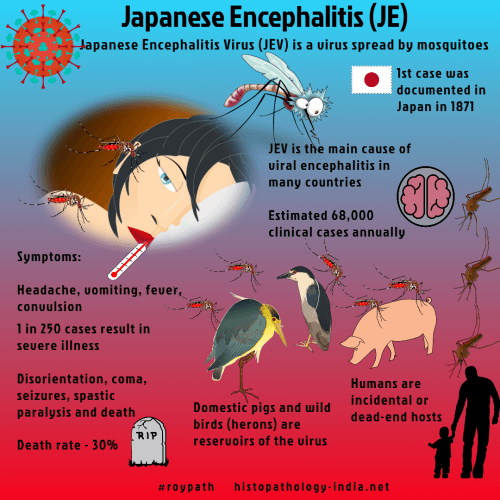|

Custom Search
|
|
Infectious Disease Online Pathology of Japanese Encephalitis
|

|
Japanese Encephalitis is a viral disease transmitted by mosquitoes. The Japanese encephalitis virus is a virus from the family Flaviviridae. This virus occurs along the Orient, from Korea and Japan in the north to India and Malaysia in the south. The disease has been recognized in Japan since 1871 and was named Japanese ‘B’ encephalitis to distinguish it from 'encephalitis A' (encephalitis lethargica, von Economo’s disease) which was then prevalent. The virus was first isolated in Japan during an epidemic in 1935. Several large epidemics have occurred since then. Epidemics show a seasonal incidence (summer-autumn) in temperate regions, though this is not evident in tropical areas. Culex tritaeniorhynchus, a rural mosquito that breeds in rice fields is the principal vector. Birds and pigs act as reservoir hosts. Japanese encephalitis virus causes the most serious clinical disease among the five viruses of this group. The disease typically has an abrupt onset with fever, headache and vomiting, rapidly progressing to encephalitis. Case fatality rate in some epidemics has been as high as 50 per cent. Recovery is sometimes associated with serious neurological sequelae, especially in infants and children. The large majority of infections are, however, asymptomic and it has been estimated that 500 to 1000 inapparent infections occur for every case of clinical disease. Japanese encephalitis was first recognized in India in 1955 when the virus was isolated from Culex vishnui mosquitoes during an outbreak of encephalitis in Tamil Nadu. Epidemic with high case fatality have occurred in West Bengal and Assam since 1973. |
|
|
